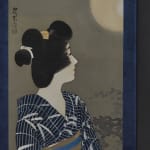Itō Shinsui (1898–1972)
Beauty under the Moon
Color and gold on silk, hanging scroll
With a Tokyo Art Club certificate
Seal: Shinsui
37.9 x 28.5 cm
114 x 34.9 cm (overall)
Further images
It may be illustrating a scene of dining in a traditional Japanese restaurant, or a relaxed dinner at home with friends in the early autumn with the lingering summer heat. Ito Shinsui might be capturing the moment, during a casual conversation after dinner, when suddenly someone amazes at the beautiful full moon, and the beauty, the protagonist, makes her turn. The shadows against the shimmering moonlight might be the bush clover in blossom in the garden. Most of the colors, such as hair in black and kimono in blue as well as the kushi and the obi in gradated browns, are of sober tones; in the moonlight, the beauty’s ruby-red lips on her snowy, silky skin stand out. This gracefulness fills the audience with much enchantment.
Shinsui once related that he prepared twice amount of the pigments needed for certain colors as he did not paint with the particles of pigments sunk to the bottom when the pigments were dissolved in water with glue. It is because Shinsui mainly applies the muted and understated tones to the present work that shows Shinsui’s expertise in bringing out the complexities of a color as masterly as the example of the sophisticated blue that makes this work an excellent piece.
Ito Shinsui (nihonga painter; 1898–1972)
Tokyo-born nihonga painter. His real name is Hajime. Studied under Kaburaki Kiyokata. Exhibited at Bunten and Teiten. His works, Hago-no-oto and Akibare, were given tokusen (special prize that grants entry without examination in the following year) at the eighth and the tenth Teiten respectively. Became one of the greatest Bijinga (painting of beauties) artists. Established an artistic style based on the ukiyo-e tradition while adopting the modern genre scene. Consultant to Jitsugetsu-sha and Nitten. Member of the Japan Art Academy.
Shinsui once related that he prepared twice amount of the pigments needed for certain colors as he did not paint with the particles of pigments sunk to the bottom when the pigments were dissolved in water with glue. It is because Shinsui mainly applies the muted and understated tones to the present work that shows Shinsui’s expertise in bringing out the complexities of a color as masterly as the example of the sophisticated blue that makes this work an excellent piece.
Ito Shinsui (nihonga painter; 1898–1972)
Tokyo-born nihonga painter. His real name is Hajime. Studied under Kaburaki Kiyokata. Exhibited at Bunten and Teiten. His works, Hago-no-oto and Akibare, were given tokusen (special prize that grants entry without examination in the following year) at the eighth and the tenth Teiten respectively. Became one of the greatest Bijinga (painting of beauties) artists. Established an artistic style based on the ukiyo-e tradition while adopting the modern genre scene. Consultant to Jitsugetsu-sha and Nitten. Member of the Japan Art Academy.





